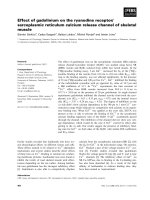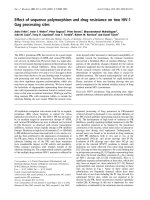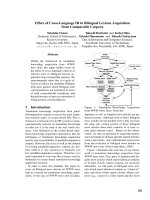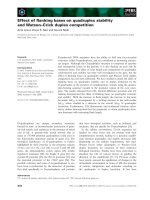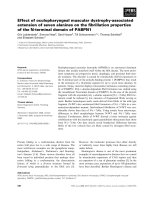Báo cáo khoa học: " Effect of ultraviolet radiation on the hatchability and survival of eggs and larvae of sheep nematode" doc
Bạn đang xem bản rút gọn của tài liệu. Xem và tải ngay bản đầy đủ của tài liệu tại đây (74.58 KB, 4 trang )
-2851$/ 2)
9H W H U L Q D U \
6FLHQFH
J. Vet. Sci.
(2004),
/
5
(1), 59–62
Effect of ultraviolet radiation on the hatchability and survival of
eggs and larvae of sheep nematode
Ademola Isaiah Oluwafemi* and Ademola Janet Ayobami
1
Department of Veterinary Microbiology and Parasitology, Univeristy of Ibadan, Ibadan, Nigeria
1
Department of Physics, University of Ibadan, Ibadan, Nigeria
The hatchability of sheep gastrointestinal nematode
eggs exposed to ultraviolet (UV) radiation and the activity
of the hatched larvae were examined. Hatchability
decreased with increasing exposure to radiation. The
difference in hatchabilityof eggs irradiated for 15,30 and
60 minutes were highly significant (p < 0.01 d
α
=3.07,
3.24 and 3.75) compared with the hatchability of the non-
irradiated eggs. The life span of irradiated larvae was
shortened, only 20% of those expose to UV radiation 60
minutes survive for 2 days as against 100% survival rate
in the non-irradiated larvae. Batches of nematode larvae
(L1) were irradiated with ultraviolet (UV) light for
varying time interval to determine the influence of
radiation on the transmission potential of the irradiated
larvae. There was a decrease in the survival rate of the
hatched free-swimming larvae that corresponded with the
increasing radiation exposure time.
Key words :
Ultraviolet radiation, hatchability, survival, nem-
atode, sheep
Introduction
Several authors have reported on the influence of such
factors as temperature, pH, light, salinity and redox potential
on hatchability of nematode eggs. Radiation influence on a
variety of living organisms has been observed to vary from
partial to total interference with normal development
process [17,14,3,15].
The Nairobi declaration on climatic change in 1990
confirmed a significant increase in trace gases which is
responsible for a gradual erosion of the stratospheric ozone
layer which is expected to lead to an increase of ultra violet
(UV) radiation at the earth surface. An argumentation of
incident biologically effective U.V.B radiation wavelength
band between 290 and 325 mm could be a serious risk factor
in the future [11,9].
In view of an expected changes in radiation intensities
associated with the mean annual global temperature
increase, the present study therefore aimed at determining
the possible influence of change in UV radiation intensities
base on length of exposure on the hatching of nematode
eggs as well as the survival rate of the larvae obtained from
the irradiated eggs and irradiated larvae.
Materials and Methods
Nematode egg recovery technique
The technique used was that previously described by
Hubert and Kerbouef (1992). Briefly, 10 to15 gm of faeces
were suspended in water and cleaned of organic debris by
filtration through sieves (1 mm and 100
µ
m) the eggs being
collected on a 20
µ
m sieve. The eggs were further cleaned
from organic debris by centrifugation in magnesium
sulphate (density 1.16) for five minutes at 1000 g. The
supernatant was filtered through 100
µ
m and 60
µ
m sieves
and the eggs were washed in water and collected on a 20
µ
m
sieve.
Egg suspension
The concentration of eggs was in five 50
µ
l samples and
adjusted to 1200 to 1300 egg ml. Bacteria are necessary for
the development of the nematode larvae and must be added
to the medium. The egg suspension was diluted with filtrate
from the first step of egg extraction, which had been
centrifuged for five minutes at 1000 g to eliminate organic
debris. To avoid the proliferation of fungi, 5
µ
g of
amphotencin
Β
(fungizon ND; squibb) was added per ml of
egg suspension.
Nutritive medium
The nutritive medium was as described by Hubert and
Kerboeuf (1984) and compose of Earles’ balance salt
solution plus yeast extract (Difco laboratories) diluted in
saline solution (1 g of yeast extract/90 ml of saline solution)
*Corresponding author
Phone: 23428107551; Fax: 23422414007
E-mail:
60 Ademola Isaiah Oluwafemi and Ademola Janet Ayobami
in the proportion 1:9 volume to volume.
Hatchability test
The test was carried out in a 90 mm diameter petri dish.
100
µ
l of egg suspension containing approximately 100
eggs was added to each of the six petri dishes used. Five of
these were exposed to UV radiation from a lamp source
emitting a wavelength of 2.54 mm from a distance of
560 mm from the base of the containers to the radiation
source. Radiation exposures of the egg batches were for 0,
0.5, 5.0, 15, 30 and 60 minutes respectively. 20
µ
l of
nutritive medium was later added to egg suspension and put
in an incubator at 27
o
C. The first stage larvae were obtained
two days later. At this time, the parasites were counted. The
counting is done for another 6 days to determine the survival
rate of the larvae. By this time the larvae has developed to
the infective third stage larvae.
Larval development test
The test was carried out in a 90 mm diameter petri dish.
100
µ
l of the egg suspension containing approximately 100
eggs was added to each of the six petridishes and put in an
incubator at 27
o
C for 48 hours. By then the parasites had
developed to first stage larvae. The larvae were then exposed
to radiation as described above and later returned to the
incubator.
Results
Egg viability and hatchability
The nematode eggs identified were
Haemonchus contortus,
Trichostrongylus colubriformis, Oesophagostomum columbianum,
Strongyloides papillosus,
and
Trichuris ovis
. Microscopic
examination of irradiated nematode eggs did not reveal any
drastic morphological changes. In the batches of eggs
exposed for 60 minutes, an insignificant number of eggs
were observed to have become darkened in colour.
The cumulative percentage (%) hatchability after two days
of incubation showed that there was a decrease in the
hatching rate of eggs exposed to irradiation as compared to
the result obtained in the control (Fig. 1). The difference in
% hatchability compared with the control was not
significant at 0.5 and 5.0 minutes irradiation level but highly
significant at 15.0, 30.0 and 60.0 minutes (p < 0.01) d
α
=
3.07, 3.24 and 3.75 respectively. After 2 days of incubation,
no further hatching of eggs occurred in the irradiated eggs.
An additional 2% of the eggs in the control batch hatched
following a further 1-day incubation. As the number of eggs
that hatched increased with the duration of hatching, the
proportion of hatched eggs at a particular time interval
varied with the radiation level (Fig. 1).
Larvae life span
The percentage survival rate (Table 1) showed that under
the experimental condition the control larvae survived for
6days while only 20% of those exposed for 60 minutes
survived for 2 days. The activity (the rate of movement) was
also radiation level dependent.
Irradiated larvae life span
Direct exposure of nematode larvae to U.V had an
inhibiting effect on the rate of activity and survival of the
larvae. The findings are presented in Table 2. While only
20% of the 60 minutes irradiated larvae survived for 2 days,
the control experiment showed that 100% of the larvae were
alive during the same period post-irradiation.
Discussion
Radiation is expected to influence living organisms to
varied degree [1,2,16]. The significance of such influence
will be related to the level of inhibition-radiation can have
on the ability of parasitic or pest organisms to maintain
F
ig. 1.
Cumulative hatchability rate of irradiated nematode egg
s.
Table 1.
Life span of nematode L1 (larvae) hatched from UV radiated eggs
Radiation level
(mins)
Time of observation (days)
0123456
0.0 100 100 86 80 80 78 75
0.5 100 80 67 50 30 0 0
5.0 100 75 59 27 8 0 0
15.0 100 69 51 25 8 0 0
30.0 100 69 44 19 8 0 0
60.0 100 50 20 0 0 0 0
Effect of ultraviolet radiation on the hatchability and survival of eggs and larvae of sheep nematode 61
continuity of life.
The present study confirms the previous findings. In spite
of unobserved drastic changes in the egg morphology or
viability of the irradiated eggs, there was a significant
interference with the hatching rates of eggs. The decreasing
hatching rate with an increasing UV irradiation exposure is
in line with the findings of Samuelson
et al
., (1984). The
decrease hatchability in eggs expose to high level of (60
minutes) of radiation might have been as a result of radiation
damage to the larvae and hence interference with larval
ability to induce hatching.
UV radiation cannot explain any inhibition in the built-up
of internal osmotic pressure needed for hatching as reported
by Kusel (1970) nor can UV support the proposed hatching
mechanism by Bair and Etges (1973) that hatching may be
induced by enzymatic degradation of the egg shell. Higgins-
Optiz and Evers (1983) observed that hatching of eggs
occurred as a result of the shell rupturing on one of the two
lateral sides of the egg surface. The observed inhibiting
effect UV light had on hatchability in this study could have
explained such distinctive longitudinal orifice but for
localised damage or focal action by enzymes [12] on the
rupture line assuming they were present. Radiation could
not have selectively affected particular location on the
eggshell. On this line of thought, the decreased activity of
larvae exposure to high exposure level, (60 minutes) might
have been as a result of radiation damage of the larvae and
hence the reduce hatchability rate with increase radiation
exposure.
However the most tenable assumption like Prah and James
(1977) suggested appears to be that the influence of UV
radiation on metabolic process in the larvae may directly
affect activity and hence survival. UV radiation also had
significant influence on larvae from hatched nematode eggs.
Investigation, reveal a reduction in the survival ability of the
irradiated larvae, suggesting a possible reduction in
transmission with respect to population dynamics of the
nematode development. It is however pertinent to mention
that this observation shows a break-point in the lifecycle of
irradiated nematode larvae for the purpose of reduction in
parasite number and transmission, particularly as there is a
level below which no transmission can successfully take
place [7].
This study did not establish the direct effect of natural UV
radiation from sunlight on the larvae which is positively
photropic, it however confirms in the future, the increase UV
reaching the earth, if not controlled have a significant effect
on organisms activity positively or negatively. A reduction in
the transmission level of nematode could be forced.
References
1. Anderson RM, Mercev JG, Wilson RA, Carter NP.
Transmission of
Schistosoma mansoni
from man to snail:
experimental studies of miracidia and age. Parasitol 1982, 85,
339-360.
2. Bair RD, Etges EJ.
Schistosoma mansoni
: factors affecting
hatching of eggs. Exp Parasitol 1973, 33, 155-167.
3. Farvar MA, Cember H. Lethal effect of gamma radiation
on the schistosome larva carrier in snail (
Australorbis
glabratus
). Am J Public Health 1969, 59, 2077-2080.
4. Higgins-Optiz SB, Evers P. Observations by scanning
microscopy of miracidia hatching from
schistosoma
mansoni
. J Parasitol 1983, 69, 43-433.
5. Hubert J, Kerboeuf D. A microlarval development essay for
the detection of anthelmintic resistance in sheep nematode.
Vet Rec 1992, 130, 442-446.
6. Keelings JED. The effect of ultraviolet radiation on
Nippostongylus muris
. Irradiation of infective larvae: Lethal
and sublethal effect. Ann Trop Med Parasitol 1960, 54, 182-
191.
7. Krakower CA. Some observations on the effect of physical
and chemical agents on the cercariae of
schistoma
mansoni.
Puerto Rico. J Public Health Trop Med 1994, 16, 26-44.
8. Kusel JR. Studies on the structure and hatching of the eggs
of
Schistosoma mansoni.
J Parasitol 1970, 60, 79-88.
9. Litchenberg F, Sadum EH. Parasite migration and host
reaction in mice exposed to irradiated cercariase of
Schistosoma mansoni
. Exp Parasitol 1963, 13, 256-265.
10. Micheals RM, Kean BH. X-radiation of S
. mansoni
.
In vivo
and
in vitro
effect. Am J Trop Med Hyg 1969, 18, 539-544.
11. Prah SK, James C. The influence of physical factors on the
survival and infectivity of miracidia of
Schistosoma mansoni
and
S. haematobium
. I. Effect of temperature and ultraviolet
light. J Helminthol 1977, 51, 73-85.
12. Samulson JC, Quinmn JJ, Caulfield JP. Hatching
Table 2. The survival rate of ultraviolet radiated nematode larvae
Radiation dose
(mins)
Time of observation (days)
123456
0.0 100 100 80 80 75 70
0.5 100 100 65 30 25 0
5.0 100 97 50 23 0 0
15.0936429 0 0 0
30.0 79 47 5 0 0 0
60.0 47 20 0 0 0 0
62 Ademola Isaiah Oluwafemi and Ademola Janet Ayobami
chemokinesis and transformation of miracidia of
Schistosoma mansoni
. J Parasitol 1984,
70
, 321-331.
13.
Sharma VP, Razdan RK, Asari MA.
Anopheles stephansi
;
effect of gamma radiation and chemosterilants on the fertility
and fitness of males for sterile male release. J Econ Entomol
1978,
71
, 449-452.
14.
Stowen D.
The effect of ultraviolet radiation on
Nippostongylus
muris. I. irradiation of infective larvae:
Lethal and sublethal effect. Ann Trop Med Parasitol 1942,
54
, 182-191.
15. The Nairobi declaration on climatic change, Nairobi, Kenya,
Acts Press African center for Technology studies 1990.
16.
Urbach F.
Potential effect of altered solar ultraviolet
radiation on human skin cancer. Photochem Photobiol 1989,
50
, 507-514.
17.
Weile WH, Mertens R.
Human wellbeing diseases and
climate. In Proceedings of the 2nd World Climate
Conference. J. Jager and H.L. Ferguson (Eds). pp. 345-359,
Cambridge University Press, Cambridge, 1991.



